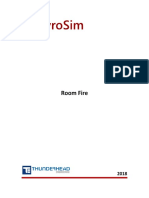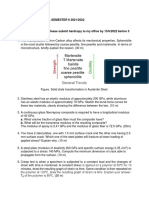1) Experiment 5 Ebp116 Instruction-2022
1) Experiment 5 Ebp116 Instruction-2022
Uploaded by
Taha RahimiCopyright:
Available Formats
1) Experiment 5 Ebp116 Instruction-2022
1) Experiment 5 Ebp116 Instruction-2022
Uploaded by
Taha RahimiCopyright
Available Formats
Share this document
Did you find this document useful?
Is this content inappropriate?
Copyright:
Available Formats
1) Experiment 5 Ebp116 Instruction-2022
1) Experiment 5 Ebp116 Instruction-2022
Uploaded by
Taha RahimiCopyright:
Available Formats
EXPERIMENT 5: MELTING AND CRYSTALLIZATION OF POLYMERS
Objective
The objectives of this experiment is study the crystallization behaviour of a selected
semi-crystalline polymer.
Materials
1. Polymer sample – Polypropylene
Apparatus (see the setup at the end of this document)
1. Hot plate
2. Polarized optical microscope with heating stage
3. Temperature control for heating stage
4. Video recording setup for spherulite growth
Procedures
All experimental procedures involve the use of polarized optical microscope
equipped with a heating stage. The temperature of the heating stage is controlled
with the suitable temperature control. So, get familiar with the required experimental
setup such as video recording setup, temperature control the heating stage and
necessary image analysis software.
Polymer thin film preparation (between glass slides)
Prepare a thin film of the given polymer sample. This is done by placing a sufficient
amount of polymer sample on a glass slide that is placed on a hot plate set a
suitable temperature (set above the melting temperature of the polymer). When the
sample has melted, place another glass slide on top of it. Carefully press the glass
slide, squeezing the molten polymer into a thin film in between the slides. Make sure
that, the sample does not exceed the edge of the slides. If that happens, prepare a
fresh sample by reducing the amount of sample used. Cool down the prepared thin
film by removing the slides from the hot plate. Conduct the same procedure for each
given sample.
Crystallization behaviour (Spherulitic Growth)
Set up the microscope heating stage so that the temperature is at
approximately 5oC below the melting temperature of PP. Prepare a fresh PP
sample film as described in the above section. As soon as equilibrium is achieved,
transfer the specimen onto the microscope heating stage which has been properly
set/focused for the best spherulite growth observation. Use the 50X objective lens
and observe the spherulite growth by recording a video using the prepared video
recording setup.
Record the change of spherulite radius at suitable time intervals and present
the data in a table format. Repeat the above procedure at a temperature of
approximately 10oC below the melting temperature of PP using the same
prepared specimen.
Transform the basic raw data to useful data that enables to study
crystallization behaviour of polymers
Your report should include discussion on the obtained Tm values by relating them to
the correct polymer sample. Also, comment on rate of crystallization (at different
crystallization temperatures), and the importance of understanding melting and
crystallization phenomena in polymer related field.
References
Bower, D.I. (2002), An introduction to Polymer Physics, Cambridge University
Press, New York.
Sperling L.H. (2006), Introduction to Physical Polymer Science, 4th edn.
Wiley-Interscience, New York
Young, R.J. & Lovell, P.A. (2011), Introduction to Polymers, 3rd edn., CRC
Press, Boca Raton.
Example of Experimental Setup
You might also like
- Astm d3895Document8 pagesAstm d3895Retno Witantri100% (1)
- 143178Document20 pages143178ipatoffNo ratings yet
- Selection of DOE Parameters in Injection Molding - Suhas Kulkarni FIMMTECH Inc PDFDocument8 pagesSelection of DOE Parameters in Injection Molding - Suhas Kulkarni FIMMTECH Inc PDFAnonymous fCp1HRwpNo ratings yet
- Expt 8 DSCDocument6 pagesExpt 8 DSCkalendakbNo ratings yet
- Lab 1 Melting PointDocument8 pagesLab 1 Melting PointalihusseinNo ratings yet
- The Examination of The Structure of PP Composites With The Glass FibreDocument4 pagesThe Examination of The Structure of PP Composites With The Glass FibreSyed Mohd MehdiNo ratings yet
- ICCEE - Volume 7 - Issue 7th International Conference On Chemical & Environmental Engineering - Pages 1-8Document8 pagesICCEE - Volume 7 - Issue 7th International Conference On Chemical & Environmental Engineering - Pages 1-8Sayed TawfeekNo ratings yet
- Experiment: E3 Title: The Study of Phase Change Duration: 2 Hours: 1 0F 5Document5 pagesExperiment: E3 Title: The Study of Phase Change Duration: 2 Hours: 1 0F 5GnabryNo ratings yet
- MethodologyDocument5 pagesMethodologyAhsanul haque JoyNo ratings yet
- Butler Belcher GermanDocument27 pagesButler Belcher GermanKumaranNo ratings yet
- O'Connor-2010-VISCOELASTIC MATERIAL MODELS OF POLYPROPYLENE FOR THERMOFORMING APPLICATIONS-PaperDocument4 pagesO'Connor-2010-VISCOELASTIC MATERIAL MODELS OF POLYPROPYLENE FOR THERMOFORMING APPLICATIONS-PaperTim OpatzNo ratings yet
- BIO 105L - CHAPTER 6 - Melting Point DeteminationDocument4 pagesBIO 105L - CHAPTER 6 - Melting Point DeteminationFranchiezca AoananNo ratings yet
- Development A High Pressure/Temperature Focused Microwave Heated Teflon Bomb For Sample PreparationDocument5 pagesDevelopment A High Pressure/Temperature Focused Microwave Heated Teflon Bomb For Sample PreparationBhargavi DusettyNo ratings yet
- Lab Rheology and Injection Molding - 1Document3 pagesLab Rheology and Injection Molding - 1Roshane NanayakkaraNo ratings yet
- Spray Best MethodDocument9 pagesSpray Best MethodS shek DhavudNo ratings yet
- CHEE3301 - Polymer Engineering - Lab 6 - Time/temperature PropertiesDocument2 pagesCHEE3301 - Polymer Engineering - Lab 6 - Time/temperature PropertiesbobNo ratings yet
- A True Boiling Point Curve Through Molecular Distillation Using FRAMOL Correlation, Winter A., 2007Document7 pagesA True Boiling Point Curve Through Molecular Distillation Using FRAMOL Correlation, Winter A., 2007Anonymous Xy309m9Sm9No ratings yet
- Ahmed KocherDocument16 pagesAhmed KocherAhmed KucherNo ratings yet
- 4-Experiment 4-Handout PDFDocument5 pages4-Experiment 4-Handout PDFOğuz YavuzNo ratings yet
- Userguide-53 enDocument12 pagesUserguide-53 enkalendakbNo ratings yet
- Lab - 3-Spin CoatingDocument3 pagesLab - 3-Spin CoatingSam StideNo ratings yet
- Organic Chemistry Laboratory: Basra University College of Science and Technology Pharmacy DepartmentDocument12 pagesOrganic Chemistry Laboratory: Basra University College of Science and Technology Pharmacy DepartmentcrtgyhujikNo ratings yet
- DSC Studies of Tactic Polypropylenes: The Correlation of Polymer Stereochemistry With Thermal PropertiesDocument20 pagesDSC Studies of Tactic Polypropylenes: The Correlation of Polymer Stereochemistry With Thermal PropertiesNaufal ArisNo ratings yet
- Burfield1990 PDFDocument20 pagesBurfield1990 PDFNaufal ArisNo ratings yet
- Melting Range or TemperatureDocument3 pagesMelting Range or TemperatureAnanda Aprilia SetiyaningrumNo ratings yet
- Freeze Drying-Principles and Practice For Successful Scale-Up To ManufacturingDocument16 pagesFreeze Drying-Principles and Practice For Successful Scale-Up To ManufacturingJuan DavidNo ratings yet
- Chapter 12 - Step by Step Manipulation of The CryoCapsul - 2014 - Methods in CelDocument16 pagesChapter 12 - Step by Step Manipulation of The CryoCapsul - 2014 - Methods in CelAJ BoonNo ratings yet
- D 2471 - 99Document3 pagesD 2471 - 99Christian HinostrozaNo ratings yet
- Characteristics of the Non-Isothermal and Isothermal Crystallization for the β Polymorph in PVDF by Fast Scanning CalorimetryDocument17 pagesCharacteristics of the Non-Isothermal and Isothermal Crystallization for the β Polymorph in PVDF by Fast Scanning CalorimetryJoshNo ratings yet
- Room Fire Model FDSDocument23 pagesRoom Fire Model FDSVlad KubinyeczNo ratings yet
- Group 6 ShakhawatDocument10 pagesGroup 6 ShakhawatShakhaoat HossainNo ratings yet
- Tdepartment of Physiology, London,: Hospital CollegeDocument13 pagesTdepartment of Physiology, London,: Hospital Collegedesi trihartatiNo ratings yet
- An Undergraduate Experiment in Polyester (PET) SynthesisDocument2 pagesAn Undergraduate Experiment in Polyester (PET) SynthesisRonald WoodNo ratings yet
- Chapter 1 - FIB SEM of Mouse Nervous Tissue Fast and - 2019 - Methods in CellDocument21 pagesChapter 1 - FIB SEM of Mouse Nervous Tissue Fast and - 2019 - Methods in CellAJ BoonNo ratings yet
- Crystallization of Polypropylene at High Cooling Rates Microscopic and Calorimetric Studies 2012 Journal of Applied Polymer ScienceDocument14 pagesCrystallization of Polypropylene at High Cooling Rates Microscopic and Calorimetric Studies 2012 Journal of Applied Polymer ScienceLubomirBenicekNo ratings yet
- MSE 160 20w Lab Manual Polymer Differential Scanning CalorimetryDocument3 pagesMSE 160 20w Lab Manual Polymer Differential Scanning CalorimetrykalendakbNo ratings yet
- Newmelting Point LabDocument9 pagesNewmelting Point LabsoulsodaNo ratings yet
- 4Document7 pages4amirswtNo ratings yet
- Thermal Stability of PLA Preforms: BackgroundDocument2 pagesThermal Stability of PLA Preforms: BackgroundPaul WardNo ratings yet
- Investigation of Phase Change Material Encapsulation by Complex CoacervationDocument8 pagesInvestigation of Phase Change Material Encapsulation by Complex CoacervationAna Silvia PrataNo ratings yet
- ASTM D 3895 2007 8pDocument8 pagesASTM D 3895 2007 8psandrasilvabr2124100% (1)
- Melting Point DeterminationDocument15 pagesMelting Point DeterminationEndi SingarimbunNo ratings yet
- 409 Chen20160314Document8 pages409 Chen20160314danyoshikusuNo ratings yet
- TN AtqtDocument47 pagesTN AtqtMinh Trần LêNo ratings yet
- Thermodynamic Lab Sheet AEAS 208Document38 pagesThermodynamic Lab Sheet AEAS 208Samiha Maysoon NooriaNo ratings yet
- Open Ended Lab ThermodynamicsDocument10 pagesOpen Ended Lab Thermodynamicsrayanjutt1042No ratings yet
- Aerosol Flow Reactor Method For Synthesis of Drug PDFDocument4 pagesAerosol Flow Reactor Method For Synthesis of Drug PDFNUR MAULIDANo ratings yet
- Me 374Document6 pagesMe 374dmupscresourceNo ratings yet
- National Training of Teachers For Critical Content in Grade 8 ScienceDocument45 pagesNational Training of Teachers For Critical Content in Grade 8 ScienceRaymond Reyes CuribangNo ratings yet
- Molecular Structure & Morphology of BOPP-PP: Optical Microscope StudiesDocument12 pagesMolecular Structure & Morphology of BOPP-PP: Optical Microscope StudiesJatinder DhaliwalNo ratings yet
- Experiment No.5 DSC AnalysisDocument2 pagesExperiment No.5 DSC AnalysisSIDDHARTH BHASNEYNo ratings yet
- High-Temperature Viscoelasticity and Heat-Setting of Poly (Ethylene Terephthalate)Document17 pagesHigh-Temperature Viscoelasticity and Heat-Setting of Poly (Ethylene Terephthalate)api-3733260No ratings yet
- Refrigeration Paper in IJSER FormatDocument14 pagesRefrigeration Paper in IJSER Formattitto84886No ratings yet
- Popcorn PhysicsDocument14 pagesPopcorn PhysicsSylvia Damarisse Villeda100% (1)
- 7crystal GrowthDocument6 pages7crystal GrowthShiva PrasadNo ratings yet
- Flash & Fire Point Test of BitumenDocument8 pagesFlash & Fire Point Test of BitumenDakshraj RathodNo ratings yet
- 124 Melting Point2Document15 pages124 Melting Point2bluestardiverNo ratings yet
- LABORATORY MANUAL FOR A MINI PROJECT: MSCB 1113 BIOCHEMISTRY & MICROBIAL PHYSIOLOGYFrom EverandLABORATORY MANUAL FOR A MINI PROJECT: MSCB 1113 BIOCHEMISTRY & MICROBIAL PHYSIOLOGYNo ratings yet
- Soalan AssignmentDocument1 pageSoalan AssignmentTaha RahimiNo ratings yet
- Estimation of Contact AngleDocument7 pagesEstimation of Contact AngleTaha RahimiNo ratings yet
- Assignment EEU104 20212022Document2 pagesAssignment EEU104 20212022Taha RahimiNo ratings yet
- Examination Schedule Sem 2 2021-2022 PPKEE V3 Updated 1 JULY 2022Document2 pagesExamination Schedule Sem 2 2021-2022 PPKEE V3 Updated 1 JULY 2022Taha RahimiNo ratings yet
- Past Perfect WorkshopDocument3 pagesPast Perfect WorkshopsantiagoNo ratings yet
- Book Bugs Rescuers of Stories Lost (Main Page)Document1 pageBook Bugs Rescuers of Stories Lost (Main Page)Yong He AnnNo ratings yet
- The Pumpkin in A JarDocument4 pagesThe Pumpkin in A Jarmiko osorioNo ratings yet
- Tracey Flyer A4 2Document1 pageTracey Flyer A4 2CareNo ratings yet
- LiveUpdate 6.2 ReleaseNoteDocument3 pagesLiveUpdate 6.2 ReleaseNoteSantiago PaviNo ratings yet
- Sinha Pushpamala Cinephilia India ReduceDocument35 pagesSinha Pushpamala Cinephilia India ReduceAtreyee GuptaNo ratings yet
- CousinDocument2 pagesCousinMamoon Malik DogarNo ratings yet
- To Be With You LyricsDocument2 pagesTo Be With You LyricsALF_1234No ratings yet
- Cosmo.1 (Version 1) (Version 1) (Version 1)Document55 pagesCosmo.1 (Version 1) (Version 1) (Version 1)Feroz KhanNo ratings yet
- FORMAT INPUT SOAL PTS 2022 Kls 8 Genap EditDocument6 pagesFORMAT INPUT SOAL PTS 2022 Kls 8 Genap EditdesmiaNo ratings yet
- Pin Out PeugeotDocument5 pagesPin Out PeugeotCüneyt Atay100% (1)
- Roshita Desthi Nurimah - A20 - TUGAS BAB 7Document34 pagesRoshita Desthi Nurimah - A20 - TUGAS BAB 7Roshita Desthi NurimahNo ratings yet
- Pool Bar Menu - 2021Document9 pagesPool Bar Menu - 2021pakumarNo ratings yet
- JSS Cas (G7&8) Topical RevisionDocument33 pagesJSS Cas (G7&8) Topical RevisionzorahsavannoNo ratings yet
- pl680 Tecsun ManualDocument27 pagespl680 Tecsun ManualRAM importsNo ratings yet
- Key With Answers 1 Yes No QuestionsDocument1 pageKey With Answers 1 Yes No QuestionsguruyasNo ratings yet
- Congo Action AidDocument39 pagesCongo Action AidPankaj DograNo ratings yet
- DESKTOP PUBLISH-WPS OfficeDocument8 pagesDESKTOP PUBLISH-WPS OfficeJames IloriNo ratings yet
- Stronglifts 5x5Document29 pagesStronglifts 5x5Daniel SeitzNo ratings yet
- Kandinsky Presentation ScriptDocument3 pagesKandinsky Presentation ScriptHannah 'Tony' BaileyNo ratings yet
- HP dvd556s: 8X USB Powered Slim Multiformat DVD Writer With LED Power IndicatorDocument2 pagesHP dvd556s: 8X USB Powered Slim Multiformat DVD Writer With LED Power IndicatorAdrian VargasNo ratings yet
- A545 730 16 50 02051 - Rev 2Document2 pagesA545 730 16 50 02051 - Rev 2csathishssnNo ratings yet
- Music Video Location Recce ClayfieldDocument2 pagesMusic Video Location Recce Clayfieldapi-636501199No ratings yet
- Final StandingsDocument6 pagesFinal StandingsNorberto AndradeNo ratings yet
- Experiment No.1: Amplitude Modulation Frequency ModulationDocument5 pagesExperiment No.1: Amplitude Modulation Frequency ModulationMahesh Manikrao KumbharNo ratings yet
- SAP ABAP - Screen NavigationDocument4 pagesSAP ABAP - Screen NavigationChandu ChandrakanthNo ratings yet
- Summer Logicals Englisch 8 10 HaureDocument6 pagesSummer Logicals Englisch 8 10 HaureWinniethewitchNo ratings yet
- Technical Standard and Specifications: Broadcast & OperationsDocument21 pagesTechnical Standard and Specifications: Broadcast & OperationsAbhishek S AatreyaNo ratings yet
- My Weekly Korean Vocab Mini BookDocument75 pagesMy Weekly Korean Vocab Mini BooknajibNo ratings yet
- CM 2019eng CatalogDocument12 pagesCM 2019eng Catalogهبال حمزةNo ratings yet





























































































